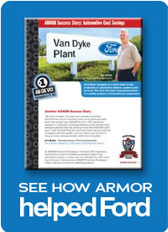 |
||
 |
||
|
VCI vs. ANTI-STAT ADDITIVES How VCIs Work Armor Protective Packaging® products utilize proprietary ARMOR Volatile/Vapor Corrosion Inhibitor (VCI) Nanotechnology. VCI are a class of corrosion inhibiting compounds which have sufficient vapor pressure to release molecules from a carrier into the air. Once released, the molecules are disseminated throughout an enclosed air space to the metal surface by diffusion. ARMOR VCI molecules attach themselves to the metal surface to form an invisible thin film only a few molecules thick. The VCI film passivates the surface and inhibits the reactions that cause corrosion. Once the VCI is adsorbed, the electrochemical process of corrosion is interrupted. The VCI layer separates the metal from the environment, providing a barrier to oxygen and water. The VCI components will even displace adsorbed water molecules from the metal surface as they form a protective layer. With the protective barrier in place, the corrosion cell is inhibited from forming. VCIs also passivate the metal surface. In the presence of even traces of moisture, the VCI components dissolve and develop strong ionic activity. The ions present in the protective layer change the potential of the metal surface. For iron and steel, the corrosion process also involves the dissolving of metal ions into the electrolyte solution. The VCI inhibitor forms an electron donor-acceptor bond with the metal which limits the dissolution of metal ions into the solution. These physical and chemical characteristics lead to self-regulating behavior in their corrosion inhibiting properties. Anti-Stat Additives Polyolefins (polypropylene, polyethylene, etc.) are inherently hydrophobic (tends to repel or not absorb water) in nature. This allows the build-up of a static charge on the surface. Excessive static causes processing problems during manufacturing and handling. This build-up also creates dust accumulation problems and static cling in end use applications. Anti-stat additive are used to prevent static charge build up on polyolefin films. Anti-stat additives can also help prevent charge build up on metal surfaces in contact with the polyolefin films. However, anti-stat films do not provide corrosion inhibiting properties like that provided by good VCI films. Static charges on the metal surface can accelerate the corrosion process and both anti-stat and VCI additives will reduce this charge. However, this is only a small part of what it takes to inhibit the corrosion process. The chart below describes anti-stat additives compared to ARMOR VCI Nanotechnology™.
Click here to download a PDF of ARMOR Technical Bulletin #122 titled “How VCIs Work: VCI Compared to Anti-Stat Additive”. For more information on Armor Protective Packaging®’s full line of corrosion management products, visit the ARMOR website or contact your ARMOR sales representative. |




